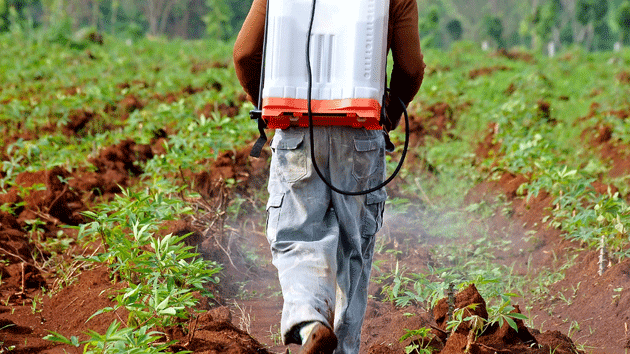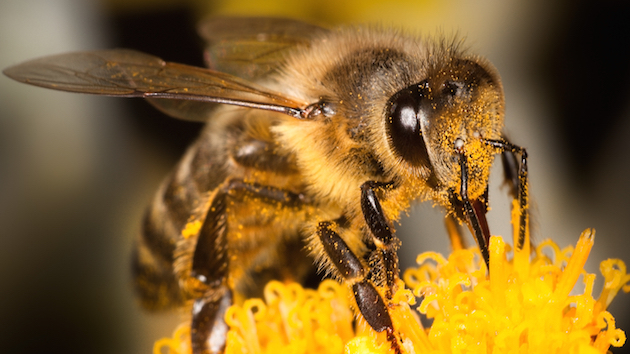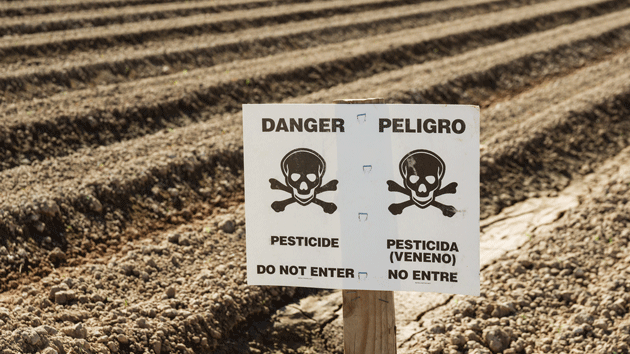
<a href="http://www.shutterstock.com/cat.mhtml?lang=en&language=en&ref_site=photo&search_source=search_form&version=llv1&anyorall=all&safesearch=1&use_local_boost=1&autocomplete_id=&searchterm=pesticide&show_color_wheel=1&orient=&commercial_ok=&media_type=images&search_cat=&searchtermx=&photographer_name=&people_gender=&people_age=&people_ethnicity=&people_number=&color=&page=1&inline=275300822" target="_blank">iamlukyeee</a>/Shutterstock
Just before the Thanksgiving holiday, the Environmental Protection Agency revoked its controversial approval of a novel herbicide mix, sending shares of its maker, chemical giant Dow, down nearly 3 percent in Wednesday trading.
The product, Enlist Duo, is the signature weed-killing cocktail of Dow AgroScience, Dow’s ag subsidiary. It’s composed of two endocrine-disrupting chemicals, 2-4-D and glypohosate, that have landed on the World Health Organization’s lists of “possible” and “probable” carcinogens, respectively. Dow markets it for use alongside corn and soybean varieties that have been genetically engineered to withstand the combined herbicides, to counter the rapid rise of weeds that have evolved to resist glyphosate alone. Approved by the EPA last year, Enlist Duo is the company’s “crown jewel,” a Wall Street analyst recently told The Wall Street Journal. The US Department of Agriculture thinks farmers will embrace it rapidly—it will boost 2,4-D use by as much as 600 percent by 2020, the agency projects.
How inconvenient for Dow’s shareholders, then, that the EPA has changed its mind. Last Tuesday, the agency petitioned the Ninth US Circuit Court of Appeals to revoke its approval of Enlist Duo, temporarily barring farmers from using it.
The reason for the reversal is fascinating. The decision hinges on the so-called “synergistic” effects of combined pesticides. When you combine two or more herbicides, do you merely get the weed-slaying properties of each—or do you also get something new and greater than the sum of the parts? There’s not a lot of data on that. Generally, pesticides are tested for safety in isolation, even though farmers tend to use several at once in the field. Yet studies have repeatedly shown—see here and here—that chemical combinations can be much more toxic than you’d expect from analyzing each of their components.
When the EPA reviewed safety data supplied by Dow, it found “no indication of synergism between [the two Enlist Duo ingredients] for mammals, freshwater fish, and freshwater invertebrates,” its court petition states, and thus it concluded that the “mixture [of the two ingredients] does not show a greater toxicity compared to either parent compound alone.”
But later, agency officials looked at Dow’s application to the US Patent Office for Enlist Duo, originally filed in 2013, and found something quite different: “claims of ‘synergistic herbicidal weed control.'” The EPA was not amused. “Specifically, Dow did not submit to EPA during the registration process the extensive information relating to potential synergism it cited to the Patent Office,” the agency complained to the court. “EPA only learned of the existence of that information after the registrations were issued and only recently obtained the information.”
In others words, Dow was assuring the EPA that its proposed cocktail was really nothing new—just the combination of two already-approved agrichemicals—while simultaneously telling the patent office that Enlist did indeed bring new and different weed-leveling properties to the farm field. In short, two different messages for two different audiences—the EPA sees potentially heightened toxicity from synergistic effects, while the investors who pore over patents might see a potential blockbuster in an herbicide mix that’s more than just the sum of its two components.
Dow has now handed that “extensive information” on Enlist Duo’s synergistic effects to the EPA. In a press release, Dow AgroSciences President and CEO Tim Hassinger vowed to resolve the EPA’s issues “in the next few months, in time for the 2016 crop use season.” Given that the EPA relies on company-supplied data to make these decisions, he’s probably right—the EPA’s action last week will amount to a speed bump on the road to Enlist Duo’s conquering of the nation’s vast corn/soybean belt. But considering the confusion so far, now might be the time for the EPA to demand independent testing of this powerful and potentially soon-to-be ubiquitous mix.
Meanwhile, last Wednesday’s action marks the second time in November the EPA has seen fit to revoke registration of a would-be blockbuster Dow pesticide. Just a week before, the agency nixed its approval of the insecticide sulfoxaflor, months after a federal appeals court found that Dow had delivered the agency “flawed and limited data” about the chemical’s impact on honeybees.













